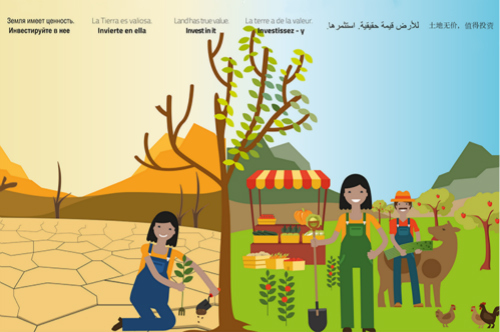
Message from Ms. Audrey Azoulay, Director-General of UNESCO, on the Occasion of World Day to Combat Desertification and Drought文章源自英文巴士-https://www.en84.com/7240.html
教科文组织总干事奥德蕾·阿祖莱防治荒漠化和干旱世界日致辞文章源自英文巴士-https://www.en84.com/7240.html
文章源自英文巴士-https://www.en84.com/7240.html
“Let us grow the future together”文章源自英文巴士-https://www.en84.com/7240.html
“共植未来”文章源自英文巴士-https://www.en84.com/7240.html
文章源自英文巴士-https://www.en84.com/7240.html
17 June 2019文章源自英文巴士-https://www.en84.com/7240.html
2019年6月17日文章源自英文巴士-https://www.en84.com/7240.html
文章源自英文巴士-https://www.en84.com/7240.html
Drought, climate change, biodiversity erosion, land degradation, intensive farming practices and poor water management, inter alia, have adversely affected our lands to the point of today’s global desertification crisis, which affects more than 165 countries worldwide.文章源自英文巴士-https://www.en84.com/7240.html
干旱、气候变化、生物多样性流失、土地退化、集约耕作以及水资源管理不善等问题,对我们的土地造成了严重不利影响,以致酿成今天殃及世界上逾 165个国家的全球荒漠化危机。
This crisis has a dramatic impact on our common environmental heritage, and poses a considerable threat to global peace and sustainable development.
这场危机严重危害我们共同的环境遗产,并对世界和平及可持续发展构成巨大威胁。
As stated by the Global Assessment Report of the Intergovernmental Science-Policy Platform on Biodiversity and Ecosystem Services (IPBES), launched on 6 May 2019 at UNESCO, there is an urgent need to take collective action to preserve the living fabric of our planet. This implies taking immediate action against desertification and drought, which is our responsibility towards future generations.
正如生物多样性和生态系统服务政府间科学政策平台(IPBES)5月6日在教科文组织发布的全球评估报告所言,我们需要紧急采取集体行动,保护地球的生命机体。这意味着要立即采取抵御荒漠化和干旱的行动,履行我们对子孙后代的应尽之责。
Desertification and drought increase water scarcity, at a time when two billion people still do not have access to safe drinking water – and over three billion may have to confront a similar situation by 2050. The world’s most vulnerable communities cannot fulfil essential water needs, sometimes causing them to migrate from lands that have become dry and barren. According to the Secretariat of the United Nations Convention to Combat Desertification, 135 million people are likely to migrate worldwide by 2030 as a result of the deterioration of lands. These migrations and deprivations are in turn a source of conflict and instability, demonstrating that desertification is a crucial challenge to peace.
荒漠化和干旱加剧了缺水问题:目前仍有二十亿人无法获得安全饮用水,到2050年将有超过三十亿人不得不面临类似状况。由于基本的用水需求得不到满足,世界上最弱势的群体往往不得不迁离业已干旱贫瘠的土地。根据《联合国防治荒漠化公约》秘书处的报告,到2030年,全球或将有1.35亿人因土地退化而背井离乡。这种移徙和匮乏反过来又成为冲突和不稳定的根源,这表明荒漠化是对和平的重大挑战。
Every year, we observe the World Day to Combat Desertification and Drought on 17 June to promote public awareness of international efforts to achieve land degradation neutrality, thanks to the tools of scientific cooperation, problem-solving and strong community involvement at the grass-roots level. UNESCO has been at the forefront of this collective endeavour, building on its scientific expertise and mobilizing its water and environmental programmes.
我们在每年6月17日纪念防治荒漠化和干旱世界日,借助科学合作、解决问题和增强基层社区参与的工具,提高公众对国际社会为达到土地退化零增长所作努力的认识。教科文组织以自身的科学专业知识为依托,利用其水和环境计划,始终走在这一集体努力的前列。
This is why finding solutions to drought and water scarcity, whether natural or humaninduced, was one of the main themes of the UNESCO International Water Conference held on 13-14 May 2019. This conference encouraged a broad and concerted commitment to implementing a global response to the challenges raised by water access and governance, anticipating and mitigating negative impacts on world peace, sustainable development and international solidarity.
正因如此,为自然和人为因素导致的干旱和缺水问题寻找解决方案,成为2019年5月13‒14日召开的教科文组织国际水资源大会的主题之一。此次会议倡导广泛而一致的承诺,以采取全球对策应对供水和治理提出的挑战,预测并降低对世界和平、可持续发展和国际团结造成的负面影响。
UNESCO has provided support to its Member States to address drought-related challenges and management by enhancing human capacity, policy guidance and existing tools. This includes drought monitoring and early warning systems for local populations in Africa, the development of drought atlas and observatories to determine the frequency and exposure to droughts by local populations, as well as the assessment of socio-economic vulnerabilities and the development of drought indicators for policy-making in Latin America and the Caribbean.
教科文组织已向其会员国提供支持,通过强化人员能力、政策指导和现有工具帮助它们应对与干旱相关的挑战和管理问题。这包括为非洲当地居民开发干旱监测和早期预警系统,为确定旱灾频率和当地居民所面临的旱灾风险而编制干旱地图集并建立观测站,以及评估拉丁美洲和加勒比地区的社会经济脆弱性并制定用于决策的干旱指标。
Working together is crucial. No progress can be achieved in the combat against desertification and drought without engaging with all actors: public authorities, actors from the private sector, scientists, associations, and local communities, especially their youth.
共同努力极为关键。要在防治荒漠化和干旱的斗争中取得进展,就必须联合所有行为者:公共管理部门、私营部门行为者、科学家、协会以及当地社区,尤其是当中的青年群体。
For it is only by working across disciplines, and doing so holistically and inclusively that we can hope to fulfil the Sustainable Development Goal on “Life on Land”, and reverse the process of desertification that is a threat to humankind.
只有通过全面、包容的跨学科方式工作,我们才有希望实现有关“陆地生物”的可持续发展目标,扭转威胁全人类的荒漠化进程。
Together, let us grow a sustainable future through respecting our lands, preserving their abundance and beauty, and working to foster inclusive solutions.
让我们敬重土地、守住它的丰饶与美丽,努力促成包容的解决方案,共植可持续的未来。

